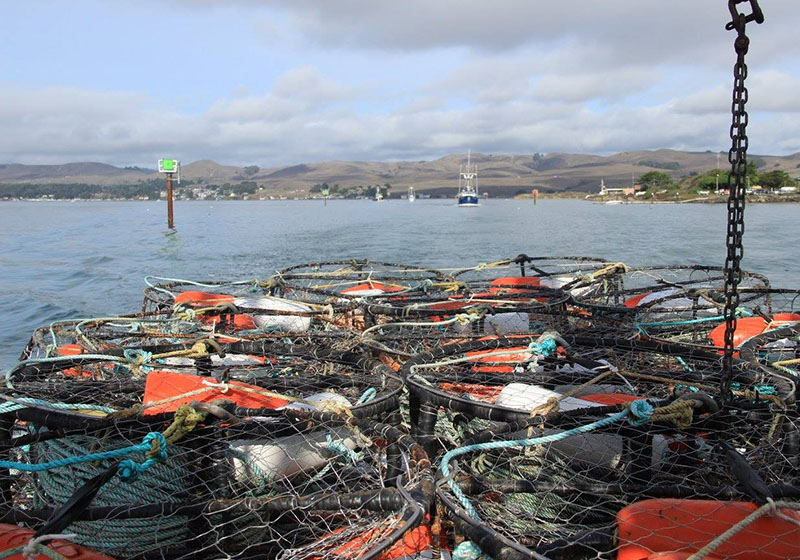California fishermen expected to be geared up this week for the Nov. 15 Dungeness crab season opener. But with another autumn aggregation of humpback whales feeding close to shore – and tough new state rules to avoid gear entanglements – the fleet is sitting tight for two weeks.
That means no fresh crab for Thanksgiving, a California coast tradition. It’s the first pre-emptive delay ordered by the state Department of Fish and Wildlife under the recently finalized Risk Assessment and Mitigation Program (RAMP). Those regulations could result in shutting down the fishery if entanglements occur.
Delaying the Dungeness crab season off California’s central coast until Dec. 1 will probably allow enough time for for humpback whales to migrate out of the area, state wildlife officials say. They will assess the whale movements and risk for entanglements in fishing gear again in the central and northern coast areas before the rescheduled opening, said Fish and Wildlife director Charlton Bonham.
“The fleet has gone to great lengths to be more nimble in order to protect whales and turtles, and the results are promising,” Bonham said in announcing the decision Nov. 5. "This year for the first time in a long time it looks like we don’t have to worry about domoic acid, which is good news.”
The California Coast Crab Association is supporting the delay, which association president Ben Platt called a “prudent decision” to avoid the possibility of an entanglement causing a shutdown.
But fishermen remain far apart from state officials and environmental groups on the extent of danger to whales and the real impact of the Dungeness fishery.
“We tried pushing them a lot on the thresholds” for ordering closures, said Platt.
From a population estimate of 2,900 humpback whales years ago, “it’s been revised to over 7,200” and the crab association is even considering a petition to the U.S. Fish and Wildlife Service to have the whales taken off the endangered list, said Platt.
“We had one confirmed entanglement last year,” he added. “We’re having zero impact.”
However, “we are being held responsible for unknown gear” that may come from longline or even recreational fishing sources, said Platt. More than three entanglement incidents now could shut down an entire season, he said.
State officials did make some improvements in the RAMP plan to allow for measured responses, said Platt.
“To their credit they did make some changes that can help keep boats on the water,” he said. The agency director can respond to new risk assessments by ordering area and gear restrictions and issuing advisories of whale movements.
Those responses can be better targeted now too with the creation of seven management zones, said Geoff Shester, a senior scientist and California campaign director for the environmental group Oceana. He’s also on the committee with fishermen and others who advise the state agency on those plans.
Before the RAMP plan, state officials were guided by a court settlement in how they respond to entanglement risks, but now there are specific rules and procedures for that decision-making, said Shester.
“You need to have a permit under the Endangered Species Act” for activities affecting protected animals, said Shester.
“What these rules do is allow the state to continue managing the fishery” without the risk of federal authorities stepping in, he said. That allows for incidental take permits that protect the fishermen from closures.”
“I think ultimately this is going to be the saving grace for the fishery,” he added.
For now, the new Dec. 1 start date is similar to the 2019 season delay that was inspired by Bodega Bay fishermen’s decision to voluntarily sit out a scheduled Nov. 22 opening to avoid whales concentrated and feeding near Point Reyes and Half Moon Bay. That decision by the Bodega Bay association led state officials to reach out to other ports and get a consensus for delaying the season.
“Kind of the same thing is happening now” in the same area, said Platt. “So whales that would be moving south and out of California are hanging around.”
“Fishermen in Monterey Bay have seen them feeding heavy, which is what they usually do just before they leave,” said Shester. In past years typically the whales got going any time from mid-November to mid-December, he said.
Looking at long-range forecasting, Fish and Wildlife officials anticipate a change in conditions will get the whales moving by the time of new aerial surveys and reassessing the risk, said Platt.
“We’re hopeful for Dec. 1,” he said. “We don’t want to lose the Christmas market.”







